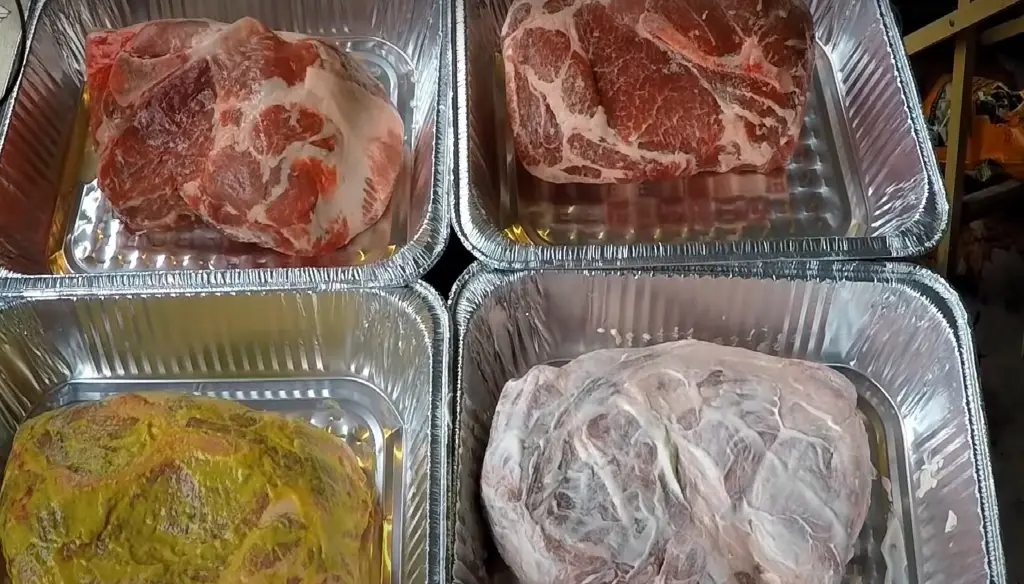Share via:
Nothing beats biting into a well-cooked steak with a delicious flavor and a juicy texture. Achieving that perfection can be a challenging task, even for experienced cooks.

You can use a steak binder to improve the flavor and texture of your steak. A binder improves the flavor and tenderness of your steak while also keeping it moist and juicy.
There are different kinds of steak binders available on the market. And how do you know which one to use?
In this grillcuisines.com guide, we’ll cover:
- Why are Steak Binders Important?
- The Importance of Choosing the Right Binder for Steak
- Top 5 Best Binder for Steaks and much more!
Why are Steak Binders Important?
When you are cooking a steak, adding a binder can really take it to the next level. A binder is simply an ingredient that you add to your steak to enhance its flavor and texture.
Binders come in different forms, like powders, marinades, and rubs. They help the steak stay juicy and tender, even after it’s been cooked.
This is because binders work by breaking down the proteins in the meat, which allows it to absorb moisture more easily.

This extra moisture keeps the steak from drying out while cooking, and results in a more delicious and juicier steak.
So depending on, whether you’re using a powder, marinade, or rub, a binder can help take your steak to the next level. Just remember to choose the right binder to match the type of steak you’re cooking and the desired end result.
Why do we call them meat binders? The reason is pretty simple – when you add a binder to your steak, it helps bind or hold the steak together. It also helps bind or hold in moisture, which results in a delicious, tender, and juicy steak.
When you add a binder, it breaks down the proteins in the meat, as a result, steaks absorb more moisture.
Now, are binders necessary to use when cooking steak? Not necessarily, but they can definitely enhance the taste and texture of your steak. It all depends on your personal preference and the type of steak.
Sometimes we use the term “marinade” instead of “binder.” We usually soak steak in a marinade before cooking it. Marinades are made up of different ingredients, like vinegar, oil, or soy sauce.
So why do we call them binders? Well, when you add a binder to your steak, it helps bind or hold the steak together. It also helps bind or hold in moisture, which results in a delicious, tender, and juicy steak.
The Importance of Choosing the Best Steak Binders
When it comes to cooking steak, the binder you use can make or break the outcome.
A wrong binder can ruin the flavor and texture of your steak, leaving it tough, dry, or even overly salty.
It is important to choose the right binder depending on the type of steak and how you want it to taste.
Related >> How To Fix Tough Cooked Steak? [8 Ways To Tenderize Steak]
For example, let’s say you’re cooking a fancy steak like filet mignon. Filet mignon has a delicate and rich flavor that you don’t want to overpower.
In this case, you might want to use a subtle binder like salt or lemon juice to enhance its natural flavor. These binders will help the steak retain its juicy tenderness and amplify its unique taste.
When cooking a tougher cut, such as flank steak, you may want to add a stronger binder to help break down the meat fibers and make it softer.
In this case, a stronger binder, like Worcestershire sauce or papaya, may be preferable. These binders are powerful enough to penetrate the meat and break down the fibers, resulting in a more tender and succulent steak.
Related >> 7 Most Tender Steak Cuts In The Market
In summary, choosing the right binder is critical in cooking the perfect steak.
By pairing the perfect binder with the type of steak, you may bring out its natural tastes and create a delectable, tender, and mouth-watering feast that your family and friends will enjoy.
So, the next time you cook steak, make sure to use the proper binder and elevate your cooking skills!
What Are Good Binders For Steaks?
| Steak Cut | Recommended Binder |
|---|---|
| Ribeye | Garlic and Herb Butter, Worcestershire Sauce Marinade |
| Filet Mignon | Mustard and Herb Rub, Balsamic Vinegar Marinade |
| New York Strip | Chimichurri Sauce, Soy Sauce Marinade |
| Sirloin | Red Wine Marinade, Montreal Steak Seasoning |
| T-Bone | Rosemary and Garlic Marinade, Steakhouse Seasoning |
| Flank Steak | Citrus Marinade, Cilantro and Lime Butter |
| Skirt Steak | Chipotle Pepper Marinade, Steak Rub |
| Hanger Steak | Red Wine Vinegar Marinade, Garlic, and Pepper Rub |
| Porterhouse | Soy Sauce and Brown Sugar Marinade, Cajun Rub |
| Tomahawk | Coffee and Chili Powder Rub, Red Wine Reduction Sauce |
| Tri Tip | Mustard and Horseradish Rub, Balsamic Glaze |
| Top Round | Italian Dressing Marinade, Herb and Garlic Butter |
| Bottom Round | Teriyaki Marinade, Chili Lime Rub |
Related >> 7 Most Tender Steak Cuts In The Market
Our Pick For 10 Best Binder For Steak
Are you ready to elevate your steak with a great binder? Check out our top 10 recommendations for a good binder for steak.
1- Worcestershire Sauce
This classic sauce is a must-have for any steak lover. Its tangy flavor and umami richness make it perfect for enhancing the natural flavor of beef. Just don’t use too much, as it can overpower the meat. Best paired with ribeye or sirloin steak.

2- Soy Sauce
Soy sauce, another staple in the kitchen, is an excellent choice for a savory, salty flavor in the steak.
It’s especially good for marinating tougher cuts of meat to make them more tender. Best paired with flank steak or skirt steak.
Related >> How Long Can Flank Steak Last At Room Temperature?
3- Balsamic Vinegar
Balsamic vinegar is the way to go, For a slightly sweet and tangy flavor in steak. Its acidity helps tenderize the meat and its unique flavor adds complexity to the dish. Best paired with filet mignon or New York strip steak.

4- Coffee Rub
Yes, you read that right. A coffee rub can add a deep, smoky flavor to your steak that pairs perfectly with the natural meaty taste. It’s a great option to add a bit of spice to the steak. Best paired with brisket or hanger steak.
5- Chimichurri Sauce for steak
This Argentinian sauce is made from a blend of herbs, garlic, vinegar, and oil. It adds a bright, fresh flavor to your steak that’s perfect for summer grilling. Best paired with flank steak.

6- Mustard as a binder for steak
Can you use mustard as a binder on steak?
Yes, Mustard is a classic steak binder that has been used for centuries. It adds a tangy flavor and tenderizes the steak, especially for dishes like grilled or oven-roasted steaks.
It can be used as a marinade or a rub and is especially good as a beef binder. The primary purpose of using mustard as a binder is to enhance flavor, provide a subtle tangy note, and help seasoning stick to the surface of the meat.
You can use mustard like Dijon or yellow mustard. These varieties are commonly used as beef binders because they have a balanced flavor profile and can complement the natural taste of the steak.
7- Butter
Butter is another popular steak binder that helps to add flavor and moisture to the steak. It can be used as a baste during grilling or melted over the top of the steak after cooking. Butter is a great option for enhancing the flavor of rich, fatty cuts of steak like ribeye or filet mignon.
8- Mayonnaise steak binder
Mayonnaise is a surprising but effective steak binder that helps to keep the meat juicy and adds a tangy flavor. You can use it as a marinade or a rub and is particularly good with leaner cuts of steak like sirloin or flank.
9- Seasoning binders For Steaks
Seasoning binders are a combination of spices and other ingredients. Seasoning binders are salt, pepper, garlic, onion, and herbs.
Some best seasoning binders for steak include Montreal Steak Seasoning and Kansas City Steak Rub.


10- Olive Oil
Olive oil can be used as a simple marinade on its own or as a base to create various herb and spice blends. It helps to keep the steak moist and adds a rich flavor. It’s a great option for those who prefer a more subtle taste and don’t want to overpower the natural flavor of the steak.
Conclusion: Best Bindere For Steaks
When it comes to pairing different binders with different types of steak, it really depends on personal preference and the specific cut of meat.
For example, a bold marinade with soy sauce and ginger might be great with a thick, juicy ribeye, while a simple herb butter would be perfect for a delicate filet mignon.
As a general rule, fattier cuts of steak can handle bolder, more flavorful binders, while leaner cuts benefit from more mild, tangy options.
Related Posts:
Best Traeger Steak Temp And Time Guide You’ll Need
How To Cook Steak On Traeger Grill (2 WAYS & 7 TIPS)
Best Way to Cook Smoked Sirloin Steak on Traeger Grill
4 Easy Recipes to Cook Steaks on Blackstone Griddle
What is a best binder for Tri Tip Steak?
When it comes to tri-tip steak, which is known for its tenderness and flavor, you don’t typically need a binder for Tri Tip like you might in some ground meat dishes.
However, if you want to add some additional flavor and moisture, you can use a simple marinade or seasoning rub rather than a traditional binder.
You can use olive oil combined with spices, herbs, and seasonings to create a flavorful crust when searing or grilling.
You can also marinate the tri-tip in mixtures of Mustard and Horseradish Rub and balsamic Glaze.
Can you use butter as a binder?
Butter can be used as a binder in some baking and pastry making, but it may not be the best choice for binding meat or other ingredients together.
Butter has a low melting point, so it may not effectively hold meat or other ingredients together during cooking.
Instead, ingredients like eggs, breadcrumbs, or grated vegetables are more commonly used as binders in savory dishes to help maintain texture and moisture.
What is best meat binder?
The choice of the best meat binder depends on the specific recipe and dietary preferences. Here are some common meat binders and their best uses:
- Egg: Eggs are one of the most versatile and effective meat binders. They add moisture, and structure, and help hold ground meat together. Eggs are commonly used in meatloaf, meatballs, and burger patties.
- Breadcrumbs: Breadcrumbs, whether fresh or dry, are excellent binders for meat dishes. They absorb moisture and help keep the meat moist and tender. Breadcrumbs are often used in meatballs, and meatloaf, and as a coating for fried or baked meats.
- Milk: Milk can be used as a binder, especially when combined with breadcrumbs or oats. It adds moisture and can create a softer texture in dishes like meatloaf.
- Oatmeal: Rolled oats or ground oats can act as a binder and add texture to meat dishes. They are commonly used in meatloaf and meatball recipes.
- Gelatin: Gelatin can be dissolved in hot water and added to ground meat to improve texture and help retain moisture. It’s often used in sausage-making and some meat recipes.
- Potato Starch: Potato starch is a gluten-free option that can be used as a binder in meat dishes. It helps to retain moisture and can create a smoother texture.
- Grated Vegetables: Grated vegetables like onions, carrots, and zucchini can act as natural binders in meat dishes. They add moisture, and flavor, and help hold the meat together.
- Tofu: Silken tofu can be blended and used as a binder in vegan or vegetarian meat substitutes. It provides moisture and helps create a firm texture.
The best meat binder for your recipe depends on factors like the type of dish you’re making, dietary restrictions, and personal preferences. Experiment with different binders to find the one that works best for your specific cooking needs.
Is mustard a good binder for steak?
Yes, mustard can be a good binder for steak. Mustard, particularly Dijon or yellow mustard, can be used to help dry rubs and seasonings adhere to the surface of the meat.
It provides a slight tangy flavor, and as it’s a liquid, it creates a thin layer to hold the seasoning in place. However, the flavor impact is minimal, and you won’t typically taste the mustard itself in the final dish.
I am a writer, editor, and publisher of Grillcuisines.com – an online blog dedicated to sharing grilling tips, accessories, and recipes to encourage more people to get outside and grill.
I’m off to find out the different types of grill foods, their seasons, and how to conduct outdoor cooking properly. I’ll also show you some of my grill-worthy cooking tools & accessories!






